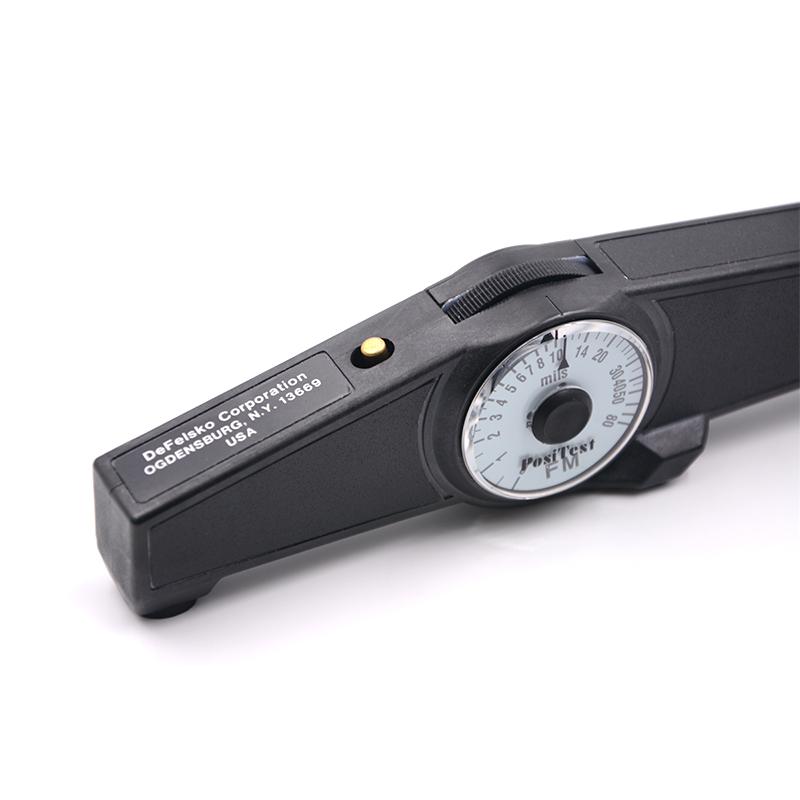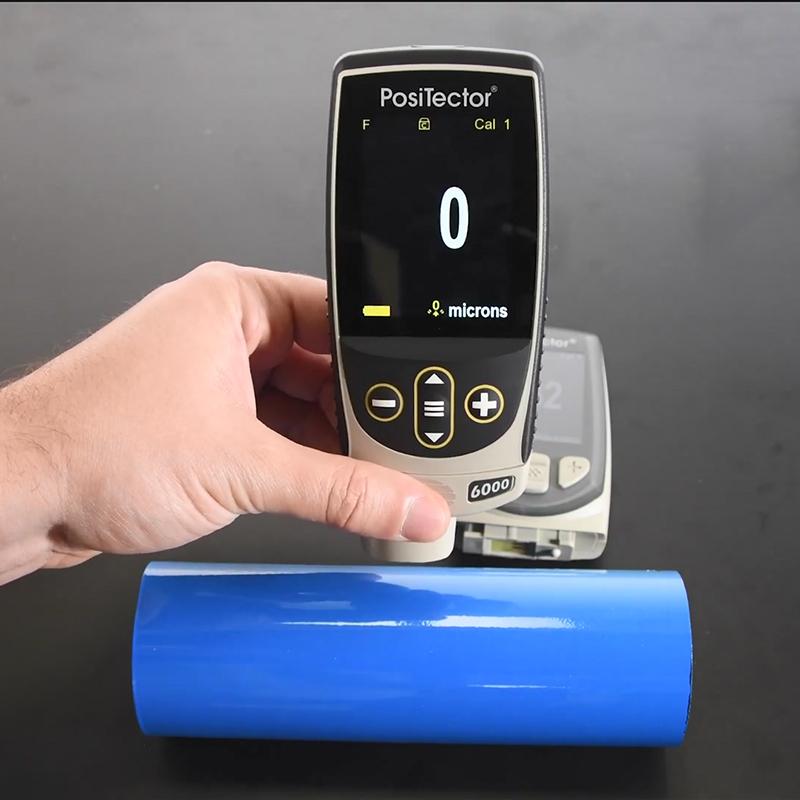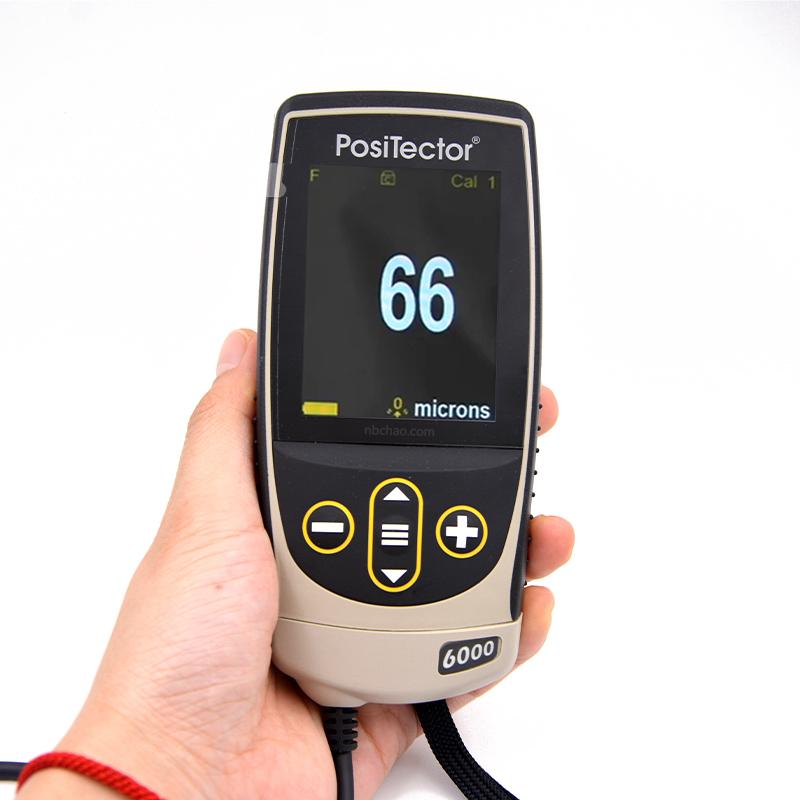Non-destructive measurement of dry coating thickness
1. Magnetic instruments are usually used to measure dry coating thickness on steel substrates. Non-magnetic operating equipment for non-ferrous metal substrates. All coating thickness measuring instruments shall be calibrated and coating thickness measured in accordance with ASTM D1186 or ASTM D1400.
2. Determining the thickness of each coating in a multi-coating system should be a checkpoint, especially when the type of each coating is different. For example, if an inorganic zinc primer/epoxy intercoat/polyurethane topcoat system is specified, each layer should be measured to ensure the correct thickness, as the coating thickness meter will not give the thickness of the individual layers on the applied coating. When measuring multilayer coatings with a nondestructive instrument, the average thickness of the first layer must be determined before applying the second layer. Obviously, the result measured after applying the second coat will be the total thickness of the two coats, and the specific thickness of the second coat can only be determined by subtracting the average thickness measured by the first coat.
Non-destructive measurement of dry coating thickness
3. Where practical conditions permit, it is recommended that a method be provided to indicate that the coating thickness is too thin or too thick so that the coating builder can make appropriate repairs. Possible methods include brushing a light coating of the same color, a compatible brush marker, chalk, or other material that can be easily removed. Crayons or incompatible spray paint should not be used.
4. The coating thickness measurement is carried out to reasonably ensure that the specified thickness is achieved. However, it is impossible to measure every square inch of surface. Both ASTM D1186 and D1400 specify that when using coating thickness measuring instruments, five separate point measurements should be made in each 9.3 square meter (100 square feet) area. Each point measurement consists of taking the average of three instrument readings in a 12.7 mm (1/2 inch) diameter circle.
5. Non-destructive dry film thickness measuring instruments are divided into three basic categories: magnetic tension meter, electromagnetic probe and eddy current probe. Destructive dry film thickness measuring instruments are handled separately.
(1) Magnetic tension meter
A magnetic tensiometer usually consists of a lever that passes through the center of a dial that holds a coil spring. The dial is located at the fulcrum of the lever. One end of the spring is connected to the lever and the other end is connected to the dial. One side of the lever contains a permanent magnet, while the other end contains a counterweight.
The spring tension overcomes the magnet’s attraction to the substrate and lifts the magnet off the coated surface. The spring tension is calibrated so that the point at which the magnet separates from the surface can be equivalent to the distance between the magnet and the surface. This distance is converted to mil (or micron). The thickness reading represents the gap between the magnet and the substrate. However, this reading may be affected by voids, rust, embedded impurities, rust, etc. Therefore, a thorough visual inspection is required during the work process to ensure that the coating is applied to a clean surface and is not contaminated during the drying process.
Non-destructive measurement of dry coating thickness
Magnetic tension coating thickness gauges must be calibrated before, during and after each use to ensure accurate measurements. The calibration method is described in ASTM D1186. The known thickness of the plastic gasket is placed directly on the polished surface and the instrument is then adjusted to be as close to the thickness of the gasket as possible. One or two gaskets representing the actual field coating thickness should be selected so that calibration can be carried out within the range of use. The user must remember that the accuracy of the magnetic tension meter is between 5% and 10% of the reading, and a slight deviation from the specified thickness is not a reason for rejection.

Non-destructive measurement of dry coating thickness
(2) Electromagnetic probe
Electromagnetic probe thickness gauges for iron surfaces are described in ASTM D1186. These instruments are also calibrated using the non-magnetic (plastic) gasket method prior to use. Most coating thickness gauges used in the corrosion control industry are of this type. They are accurate (±3% to 5% readings, depending on the manufacturer), provide a digital display of thickness, and eliminate user interpretation of analog scales. In addition, this type of instrument is usually equipped with a microprocessor that stores the measurement data and performs a statistical evaluation of the stored data, including the mean, standard deviation, highest and lowest readings, and the total readings obtained. This data can often be downloaded to a computer and/or printer and can save a lot of time associated with manually measuring documents, averaging, and determining thickness ranges. However, because these instruments are electronic, they are more delicate and more susceptible to field damage than mechanical tension meters. In addition, these instruments are more sensitive to rough surfaces.

Non-destructive measurement of dry coating thickness
Eddy current probe thickness gauges are described in ASTM D1400 for measuring the thickness of non-conductive coatings applied to non-ferrous metal substrates. The probe is excited by an alternating magnetic field within the metal and measured by modifying the electrical characteristics of the probe coil. The extent of these changes is determined by the distance of the probe from the substrate and is shown as the coating thickness on the thickness meter. The eddy current probe thickness gauge is calibrated using a plastic gasket on a non-ferrous metal substrate in a manner similar to an electromagnetic probe. Some instruments combine the electromagnetic probe and eddy current probe functions into a single unit.

(3) Precautions
Some precautions are required when using any instrument with magnets. The magnet is exposed, so it is easy to attract iron filings, steel pellets or particles. During use, the magnet must be cleaned, otherwise it will lead to incorrect readings. If the instrument is used on a soft coated film, a plastic gasket can be placed on top of the surface to prevent the magnet from deforming the coating. The distance from the edge of any surface to the instrument must not be less than 1 inch; The presence of residual magnetism in the structure of the measured coating can have a false effect on the reading. Dial type instruments (magnetic tensile thickness gauges) also present an additional problem of “human error” during use, as it is easy to continue turning the dial after the point at which the magnet is lifted from the surface, which will result in incorrect thickness measurements. Therefore, it is necessary to ensure that the dial is stopped at the point where the magnet is unadsorbed from the surface.
6. The inspector shall record the date and location of the measurement, the type of coating tested (primer, intermediate coat, top coat), the product and the type of measuring instrument used, the calibration method and whether the inspection area conforms to the specifications.
